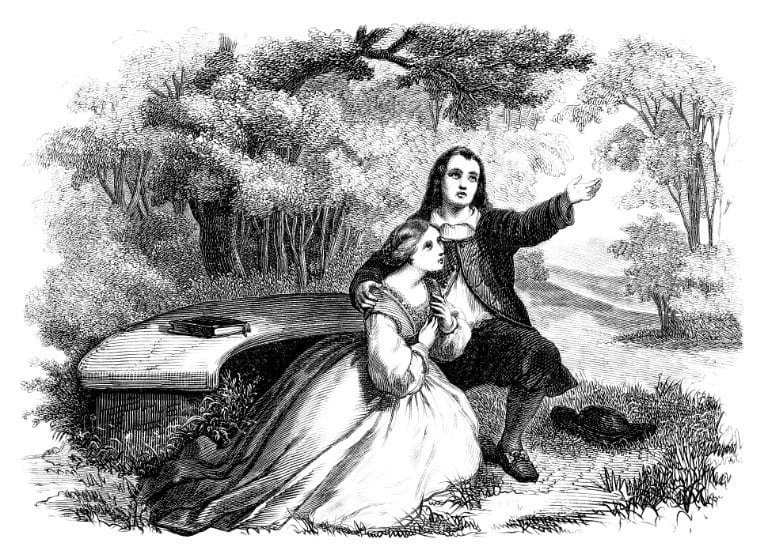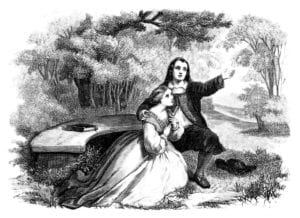It’s said that in Shakespeare’s England, reading and writing were regarded as separate skills, and though reading skills were quite widespread, the ability to write was less common. For example it may be that Shakespeare’s wife Anne and his two daughters Susanna and Judith were fluent readers, but couldn’t write. Whatever the truth of that, literacy emerges from the plays and poems themselves as a perfectly routine phenomenon, and evidence of the ability to read and write is quite pervasive.
Books are evidently a common feature of the world the plays evoke. In ‘Hamlet’, for example, Polonius encourages his daughter to ‘Read on this book’ to illustrate ‘Your loneliness’ for her encounter with the prince; similarly bogus is Buckingham’s advice to Richard in ‘Richard III’, that if the aspirant monarch wants to seem pious, he should ‘get a prayer-book in your hand’. Perhaps the best-known books in Shakespeare are those that Prospero studied in Milan as he educated himself in the magical powers that give him command of the storm in ‘The Tempest’. It may be significant that the word ‘book’ or ‘books’ is used over 140 times in Shakespeare’s works.
Letters are still more common. These seem to fall into two types. First there is the purely functional type: for example Macbeth’s letter to his wife describing his encounter with the witches, or (more prosaic still), the letter that recalls Othello to Venice. Claudius’s letter to the King of England inviting him to do away with the prince may belong in this category, alongside Hamlet’s letter to Claudius informing him that he is on his way back to Elsinore. The message from Delphos in ‘The Winter’s Tale’ that confirms that Hermione has been faithful to Leontes is a further example.
By and large these letters and messages merely advance the plot in the direction it was already taking. Other letters in Shakespeare’s plays and poems play a more pivotal role. The letter Edmund forges in ‘King Lear’ that persuades the ageing Gloucester that his son Edgar cannot be trusted is one example; Cassius’s forgery that encourages Brutus to join the plot against Caesar in ‘Julius Caesar’ is another. A third might be the documents the Duke of Aumerle fails to conceal from his father Edmund of Langley in the closing act of ‘Richard II’ containing plans to murder the king – and immediately denounced as ‘Treason! Foul treason!’ A fourth might be the documentary evidence that convicts Cambridge, Scroop and Northumberland of treachery in ‘Henry V’. A final example: the letter Friar Lawrence sends to Romeo in exile in Mantua, explaining the plan to re-unite him with Juliet. Famously, the letter fails to find its target, and the consequences are catastrophic.
Documents like these – forged letters, plans for insurrection, notes that go missing – associate literacy with deceit and disaster, but there is another side to writing in Shakespeare’s work, which associates writing (and reading) with love. One example is Hamlet’s love letter to Ophelia which she passes on to her father, who proceeds to read it out to the king and queen. How far Hamlet means what he says here may be open to question. Proteus’s love letter to Julia in ‘The Two Gentlemen of Verona’ – which she tears up, then reassembles – is a second example, while, to underline that love letters are not confined to the plays alone, a third case concerns the young woman central to ‘A Lover’s Complaint’, tearing up love letters and throwing them into the stream as she laments her folly in falling for her former lover’s charms.
Love poems are a second expression of this, and perhaps more dependable as expressions of true feeling. The four young men who fall in love with the four young women in ‘Love’s Labour’s Lost’ are certainly sincere in their affections – or so it would seem to judge by their poems – and the same can be said of Ganymede in ‘As You Like It’, who distributes his clumsy but heartfelt love poems throughout the forest. Less sincere, perhaps, is Edward III in the play named after him, whose literary skills are less prominent than his desire for his hostess, the Countess of Salisbury, leaving him no other option than to invite his secretary Lodowick to write a love poem to her on his behalf. Lodowick makes the mistake of praising (among other virtues) her chastity, and the project is abandoned.
The use of a servant to write a love poem is perhaps less surprising in a monarch than in the more middling sort: after all, one might expect the king’s chief servants to have polished literacy skills. A less dependable servant is Costard in ‘Love’s Labour’s Lost’, who is asked to deliver two love letters, and mixes them up with predictable consequences. Even so, an otherwise unimportant moment in ‘Romeo and Juliet’ may suggest that reading and writing are more common than one might imagine, even among the least elevated in society. The occasion is the Capulets’ party, and Capulet casually hands a servant a note containing the names of those he wants to be invited: ‘find those persons out / Whose names are written there’, he instructs one of his staff, and the instruction is met with equanimity. Evidently the servants can read too: all in a day’s work.




